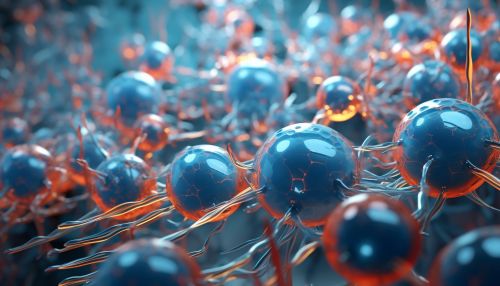Exoelectrogen
Introduction
Exoelectrogens are a group of microorganisms that have the unique ability to transfer electrons to external surfaces during the process of anaerobic respiration. This phenomenon, known as extracellular electron transfer (EET), is a key mechanism in the microbial conversion of organic and inorganic matter into electrical energy.


Biological Mechanisms
Exoelectrogens utilize specialized structures known as pili or nanowires, which act as biological conductive wires to facilitate the transfer of electrons to an external electron acceptor. These microorganisms are able to convert chemical energy, derived from the oxidation of organic or inorganic substrates, into electrical energy. This process is a form of bioelectrochemical system, which is a system that drives interconversions between chemical energy and electrical energy using microorganisms.
Types of Exoelectrogens
There are several types of exoelectrogens, including but not limited to, species of the genera Shewanella and Geobacter. These two genera are the most extensively studied due to their high electrochemical activity and their ability to produce electricity in microbial fuel cells.
Shewanella
Shewanella species are Gram-negative bacteria that are known for their versatile electron-accepting capabilities. They are capable of using a wide range of substances as terminal electron acceptors, including insoluble minerals.
Geobacter
Geobacter species are also Gram-negative bacteria and are often found in environments with low oxygen levels. They are known for their ability to oxidize organic compounds and reduce insoluble iron and manganese oxides.
Applications
Exoelectrogens have a wide range of potential applications due to their unique ability to transfer electrons to external surfaces. These applications span various fields, including bioenergy, bioremediation, and biosensor development.
Bioenergy
Exoelectrogens play a crucial role in the generation of bioenergy. They are used in microbial fuel cells (MFCs), a type of bioelectrochemical system that converts chemical energy into electrical energy using microorganisms.
Bioremediation
Exoelectrogens can also be used in bioremediation, a process used to treat contaminated water and soil. They can reduce heavy metals and other pollutants, thereby detoxifying the environment.
Biosensors
Exoelectrogens can be used to develop biosensors, devices that use biological molecules to detect the presence of chemicals. These biosensors can be used in various fields, including environmental monitoring, food safety, and healthcare.
Future Research
While the study of exoelectrogens has provided valuable insights into the mechanisms of extracellular electron transfer and its applications, there is still much to learn. Future research will likely focus on improving our understanding of the diversity of exoelectrogens, the mechanisms of electron transfer, and the optimization of their applications in bioenergy, bioremediation, and biosensor development.
